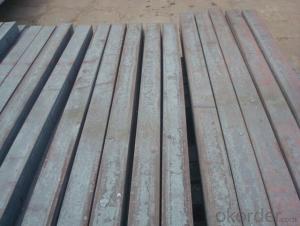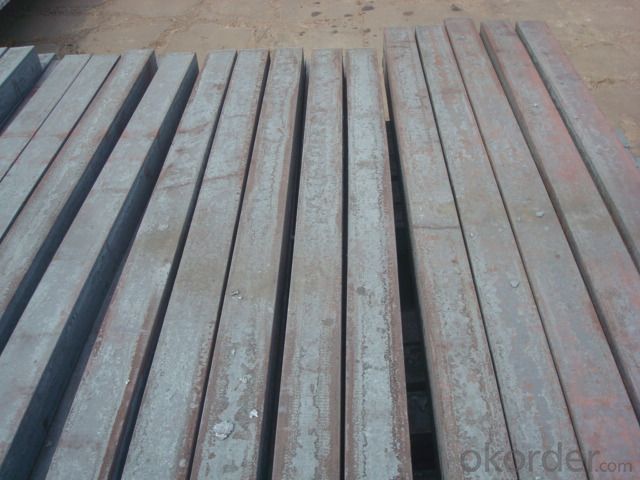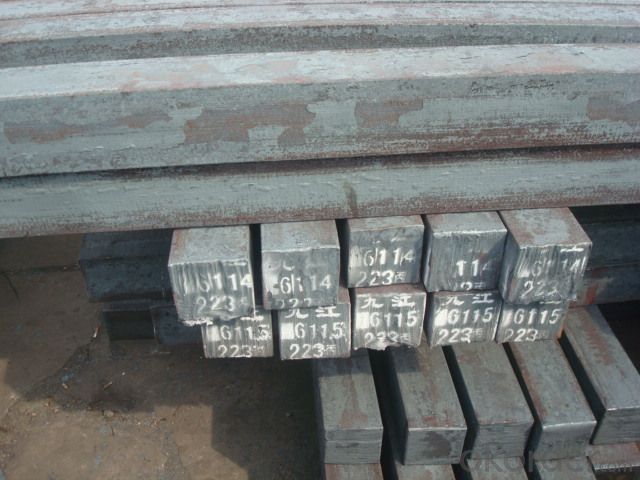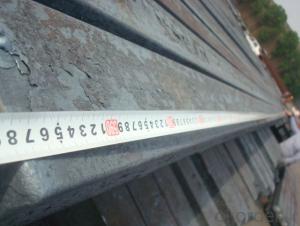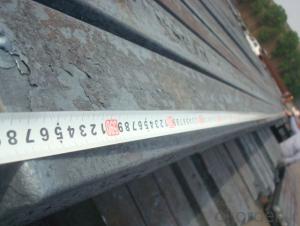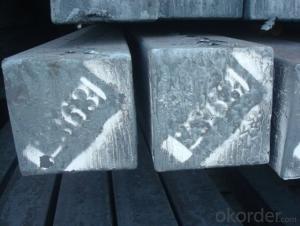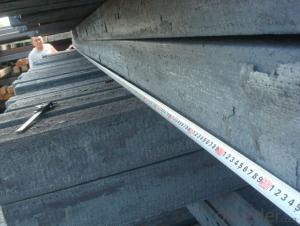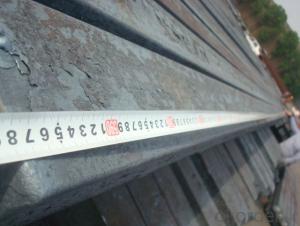Continue Casting Steel Billets/Blooms by Blasting Furnace
- Loading Port:
- Tianjin
- Payment Terms:
- TT OR LC
- Min Order Qty:
- 1000 m.t.
- Supply Capability:
- 100000 m.t./month
OKorder Service Pledge
OKorder Financial Service
You Might Also Like
Continue Casting Steel Billets/Blooms by Blasting Furnace
1.Structure of Continue Casting Steel Billets/Blooms by Blasting Furnace
Continue Casting Steel Billet by Blasting Furnace is the raw material of all kinds of steel mill. Billet section of square, round, flat, rectangular and abnormity, etc Several, mainly related to shape of rolled products. Simple rolled section steel, choose cross section of square billet or rectangular billet. rolling The sector products such as flat steel, Angle steel, select the rectangular billet or slab. Had better profiled billet when production beams, channels, and in rolling process Lines and improve the yield. The raw material of round billet is the production of seamless tube.
2.Main Features of Continue Casting Steel Billets/Blooms by Blasting Furnace.
Continue Casting Steel Billet by Blasting Furnace section size should meet the requirements of rolling deformation and finished product quality, but also roll strength and biting condition of restrictions. General steel Billet section height H. And the roll diameter D The ratio of the ( namely H/D) Should be less than or equal to zero 0.5 . Length of steel billet by finishing temperature, Rolling time and the length of the product Or times ruler. When heated too long accident prone to bump the furnace wall of steel, too short, furnace bottom utilization rate is not high, influence the heating furnace production. For the production Choose a variety of steel and steel billet, should consider the affinities of billet, as far as possible in order to improve the productivity of the roughing mill, simplify the stock management of workshop.
There are three shapes of the steel billets: square billet, slab, rectangular billet The Chinese billet, rectangular billet is mainly suitable for rolling hot rolled strip, building reinforced bar, Ordinary wire, high speed wire rod and various small profile. Of the slab are mainly used for rolling plate and hot coil sheet.
3. Continue Casting Steel Billets/Blooms by Blasting Furnace Images
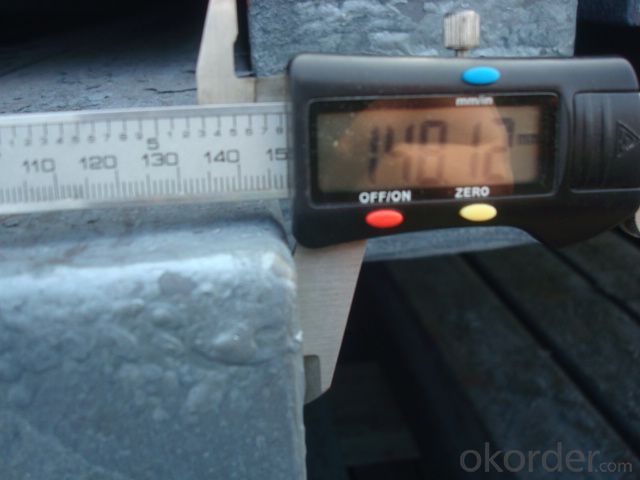
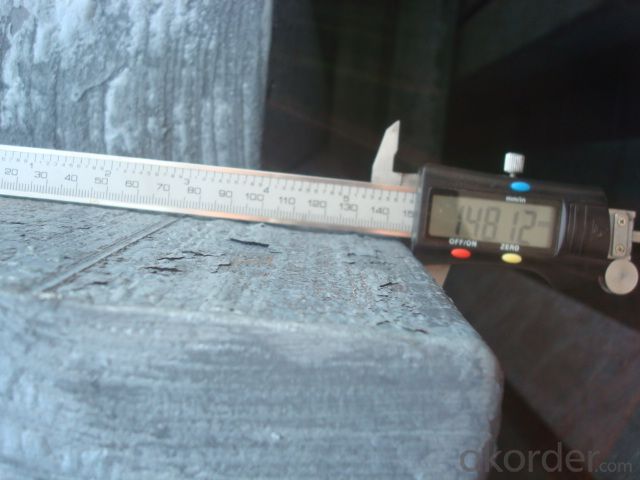
4. Continue Casting Steel Billets/Blooms by Blasting Furnace Specification
Continue Casting Steel Billet by Blasting Furnace rolled steel, after processing can be used for mechanical parts, forging parts, processing all kinds of steel, steel Q345B channel steel, wire rod is the role of the billet. Steel billet is used in the production of semi-finished products, generally cannot be used directly for the society. Steel billets and steel are strictly divided into standard, cannot decide to whether the business enterprise of the final product, and according to unified standards to perform the whole society. Typically, billet and the steel is relatively easy to distinguish, but for some steel billet, and have the same specification and same steel purposes (such as rolling tube billet), whether can be used for other industries, whether through steel processing process, whether through a finished product rolling mill processing to distinguish
Material standard The editor Range of thickness: 150-240 - mm + / - 5 mm width range: 880-1530 - mm + / - 20 mm Length: 3700-10000 - mm + / - 500 - mm Cross-sectional size: 64 * 64; 82 * 82; 98 * 98; 124 * 124; 120 * 150; 152 * 164; 152 * 170 mm Length: 9000 mm Section of tolerance: billet: 1.0 + / - 2.0-1.0 + / - 1.0 mm slab: width: + / - 2.0 mm thickness: + / - 3.0 mm The length tolerance: + / - 200 mm Section diagonal tolerance: 3.5-8.0 MM Billet section size protrusions requirements: < 1242 mm, do not allow; > = 1242 mm, < = 2 mm 1242 mm, < = 3 mm Beheading (shear) extension deformation: < 1242 mm billet: no control; The slab: < = 15 mm Surface tilt: no more than billet section 0.1 Bending: every 1 m length is not more than 10 mm The distortion: length < = 5 m, < = 11. ; The length of the < = 7.5 M, < = 5. Material % 3 sp/PS chemical composition: C Mn Si S P
5.FAQ of Continue Casting Steel Billets/Blooms by Blasting Furnace
We have organized several common questions for our clients,may help you sincerely:
①How about your company?
A world class manufacturer & supplier of castings forging in carbon steel and alloy steel,is one of the large-scale professional investment casting production bases in China,consisting of both casting foundry forging and machining factory. Annually more than 8000 tons Precision casting and forging parts are exported to markets in Europe,America and Japan. OEM casting and forging service available according to customer’s requirements.
②How to guarantee the quality of the products?
We have established the international advanced quality management system,every link from raw material to final product we have strict quality test;We resolutely put an end to unqualified products flowing into the market. At the same time, we will provide necessary follow-up service assurance.
③Could I know the process of the producing?
Sure.Steel billet is produced by the method of through three processes: It is through the steelmaking system of continuous casting equipment, directly by the molten steel pouring into billet; The second is the steelmaking system in the production of steel ingot casting billet through system of steel rolling rolling equipment or processing of steel semi-finished products; Three is the steelmaking system production of steel ingot by forging the semi-finished product processing equipment.
- Q: How are steel billets used in the manufacturing of valves and fittings?
- Steel billets are used in the manufacturing of valves and fittings as the starting material. These billets are heated and then mechanically or forge pressed to shape them into the desired valve or fitting component. The billets provide the necessary strength and durability required for these critical components in various industries.
- Q: How long do steel billets last?
- The longevity of steel billets varies depending on multiple factors, including their storage conditions and utilization. Provided that they are stored appropriately in a controlled environment with low humidity and shielded from corrosion, steel billets can endure indefinitely. Conversely, if they are exposed to harsh weather, excessive moisture, or corrosive substances, their lifespan can be significantly diminished. As for their usage, steel billets are typically melted and transformed into other steel products, such as bars, rods, and beams. The lifespan of the final product hinges on its specific application and the maintenance practices implemented. Generally, steel products are renowned for their durability and longevity, rendering them a dependable option in numerous industries.
- Q: What is the role of steel billets in the manufacturing of railway signaling systems?
- The manufacturing of railway signaling systems relies heavily on steel billets. These billets are crucial as they serve as the primary raw material for producing various components necessary for the functioning of these systems. Railway signaling systems have the responsibility of ensuring the safe and efficient movement of trains on the tracks. They consist of a complex network of electrical and mechanical devices that control traffic flow, provide information to train operators, and maintain a safe distance between trains. To manufacture these systems, steel billets are utilized in multiple ways. Firstly, structural components of railway signaling systems, such as signal poles, posts, and brackets, are produced using steel billets. These components provide support for the signaling devices, including lights, signals, and indicators. Steel is chosen for these structural elements due to its high strength, durability, and resistance to environmental factors like wind, rain, and temperature fluctuations. Secondly, steel billets are used in the production of various electrical components required in railway signaling systems. These components, including wiring conduits, junction boxes, and mounting plates, house and protect the electrical connections and circuitry. Steel's electrical conductivity properties make it an ideal material for these applications. Furthermore, steel billets are also employed in manufacturing mechanical components within railway signaling systems. These components, such as gears, levers, and linkages, facilitate the movement and operation of the signaling devices. Steel's mechanical properties, such as hardness and ability to withstand high loads, ensure the reliability and longevity of these mechanisms. In conclusion, steel billets are indispensable in the manufacturing of railway signaling systems as they provide the necessary raw material for producing structural, electrical, and mechanical components. Their strength, durability, electrical conductivity, and mechanical properties make them well-suited for the demanding requirements of these systems, ultimately contributing to the safe and efficient operation of railways.
- Q: What are the different surface treatments for improved surface roughness in steel billets?
- To enhance the surface roughness of steel billets, there are various surface treatments available. These treatments aim to improve the quality and properties of the billets, making them more suitable for different industrial applications. Some commonly used surface treatments for achieving better surface roughness in steel billets are as follows: 1. Shot Blasting: In shot blasting, high-speed abrasive particles are used to bombard the surface of the steel billets. This treatment effectively removes any contaminants, scale, or unevenness present on the surface, resulting in a smoother and more uniform finish. 2. Acid Pickling: Acid pickling involves immersing the steel billets in an acid solution, typically hydrochloric or sulfuric acid. This chemical treatment dissolves any oxides, rust, or scale present on the surface, leaving behind a clean and smoother surface. 3. Mechanical Grinding: Mechanical grinding employs abrasive wheels or belts to remove material from the surface of the steel billets. This treatment is particularly effective in eliminating deep scratches, pits, or irregularities, resulting in a smoother and more polished surface. 4. Electrochemical Polishing: Electrochemical polishing is an electrochemical process that combines chemicals and electrical current to remove a thin layer of material from the steel billet's surface. This treatment helps eliminate any surface imperfections, resulting in a smoother and more reflective finish. 5. Roller Leveling: Roller leveling involves passing the steel billets through a set of rollers that exert pressure on the surface, flattening and smoothing out any irregularities. This treatment is especially effective in improving the flatness and surface roughness of the billets. 6. Thermal Treatment: Thermal treatment, such as annealing, can also enhance the surface roughness of steel billets. Annealing involves heating the billets to a specific temperature and slowly cooling them to relieve internal stresses and improve the surface finish. It is crucial to consider the specific requirements of the steel billets and the desired surface roughness when selecting a surface treatment. Each treatment has its advantages and limitations, and factors such as the type of steel, dimensions of the billets, desired surface finish, and cost-effectiveness should be taken into account when choosing the most suitable treatment.
- Q: Is there an export duty? Or is there a tax refund?
- It's too broad. What kind of material (contains all kinds of metal components in order to confirm HS coding)?
- Q: What are the disadvantages of using steel billets?
- There are several disadvantages of using steel billets in various industries. Firstly, steel billets are quite heavy and bulky, making them difficult to handle and transport. This can increase logistical challenges and costs, especially when large quantities of billets need to be moved. Secondly, steel billets require a significant amount of energy and resources to manufacture. The production process involves melting down iron ore and various additives, which consumes a substantial amount of energy and contributes to carbon emissions. This makes steel billets less environmentally friendly compared to other materials. Additionally, steel billets have limited versatility in terms of shape and size. Their initial form is typically a long, rectangular bar, which limits their applicability in certain industries that require complex or intricate shapes. This can lead to additional processing steps and costs to transform the billets into desired forms. Furthermore, steel billets have a high risk of surface defects and internal flaws. During the manufacturing process, impurities and non-uniformities can occur, leading to cracks, inclusions, or segregations within the billets. These defects can compromise the structural integrity and performance of the final product, potentially resulting in failures or safety risks. Lastly, steel billets are susceptible to corrosion, particularly in harsh or corrosive environments. This can significantly reduce their lifespan and necessitate frequent maintenance or protective coatings to prevent deterioration. The costs associated with corrosion prevention and maintenance can add up over time, making steel billets less cost-effective in certain applications. Overall, while steel billets are widely used due to their strength and durability, their disadvantages in terms of weight, energy consumption, limited versatility, potential defects, and susceptibility to corrosion should be taken into consideration when choosing the appropriate material for a specific application.
- Q: What are the different methods of steel billet surface cleaning?
- Steel billet surface cleaning can be achieved through various methods, each with its own set of advantages and disadvantages. Some commonly used methods include: 1. Shot Blasting: By propelling small metallic or non-metallic particles at high speeds onto the billet surface, rust, scale, and other contaminants are effectively removed. Shot blasting is a quick and efficient method for cleaning large surfaces. However, it may result in surface roughness and may not be suitable for all types of steel. 2. Acid Pickling: This method involves immersing the steel billet in an acid solution, typically hydrochloric or sulfuric acid, to eliminate scale and rust. The acid reacts with the surface contaminants, dissolving them and leaving a clean surface. Acid pickling is particularly effective in removing stubborn scale and rust. However, it requires careful handling of corrosive acids and proper waste disposal. 3. Mechanical Cleaning: Mechanical cleaning methods utilize abrasive tools or brushes to physically scrub the billet surface. This can be done manually or with the assistance of machinery. Mechanical cleaning effectively removes loose contaminants and scale. However, it may not be suitable for heavily rusted or firmly adhered contaminants. 4. High-Pressure Water Jetting: This method employs high-pressure water jets to cleanse the billet surface. The force of the water effectively removes scale, rust, and other contaminants. High-pressure water jetting is environmentally friendly as it does not involve the use of chemicals. However, it may not be as effective in removing heavy scale or rust. 5. Ultrasonic Cleaning: Ultrasonic cleaning entails immersing the steel billet in a tank filled with a cleaning solution and subjecting it to high-frequency ultrasonic vibrations. These vibrations generate tiny bubbles in the cleaning solution, which collapse on the billet surface, effectively eliminating contaminants. Ultrasonic cleaning is highly efficient in removing even microscopic particles and can reach complex geometries. However, it may not be suitable for large-scale cleaning operations. Each method possesses its own unique strengths and limitations. The selection of a specific method depends on factors such as the type and condition of the surface contaminants, time and cost constraints, and the desired surface finish.
- Q: What are the advantages of using steel billets in construction?
- There are several advantages of using steel billets in construction: 1. Strength and Durability: Steel billets are known for their high strength and durability, making them ideal for construction purposes. They can withstand heavy loads and extreme weather conditions, ensuring the longevity and stability of the structure. 2. Versatility: Steel billets can be molded and shaped into various forms, allowing for flexibility in design and construction. This versatility makes them suitable for a wide range of applications, from beams and columns to framing and foundations. 3. Cost-effectiveness: Despite the initial cost of steel billets being higher than other construction materials, their long-term benefits outweigh the investment. Steel is low maintenance, doesn't require frequent repairs or replacements, and offers excellent fire resistance, reducing insurance costs. 4. Sustainability: Steel is a highly sustainable material due to its recyclability. Steel billets can be recycled and reused without losing their properties, reducing the demand for virgin materials and minimizing environmental impact. 5. Speed of construction: Steel billets are pre-fabricated, meaning they are manufactured off-site and then transported to the construction site. This significantly reduces construction time and allows for faster completion of projects. 6. Resistance to pests and rot: Unlike wood, steel billets are not susceptible to termites, pests, or rot. This eliminates the need for chemical treatments or regular inspections, saving both time and money. 7. Design flexibility: Steel billets offer a wide range of design possibilities, enabling architects and engineers to create unique and aesthetically pleasing structures. The ability to span large distances without the need for additional support columns allows for open floor plans and creative architectural designs. In summary, the advantages of using steel billets in construction include their strength, durability, versatility, cost-effectiveness, sustainability, speed of construction, resistance to pests and rot, and design flexibility. These factors make steel billets an excellent choice for various construction projects, ensuring sturdy and long-lasting structures.
- Q: Can steel billets be used in the production of energy infrastructure?
- Certainly, energy infrastructure can be produced using steel billets. Steel is extensively utilized in the construction of various energy infrastructure components, including power plants, transmission towers, pipelines, and wind turbine towers. By further processing and shaping semi-finished steel products known as steel billets, the required forms for these infrastructure projects can be achieved. The durability, strength, and versatility of steel make it well-suited for withstanding the demanding conditions and heavy loads associated with energy infrastructure. Moreover, steel provides excellent resistance against corrosion, which is of utmost importance for infrastructure exposed to the elements. In summary, the use of steel billets plays a crucial role in the production of energy infrastructure, ensuring the reliable and efficient generation, transmission, and distribution of energy.
- Q: How are steel billets used in the production of mining equipment?
- Steel billets are used in the production of mining equipment as they serve as the raw materials for various components such as gears, shafts, and structural frames. These billets are shaped, machined, and welded to create strong and durable parts that can withstand the harsh conditions of mining operations.
Send your message to us
Continue Casting Steel Billets/Blooms by Blasting Furnace
- Loading Port:
- Tianjin
- Payment Terms:
- TT OR LC
- Min Order Qty:
- 1000 m.t.
- Supply Capability:
- 100000 m.t./month
OKorder Service Pledge
OKorder Financial Service
Similar products
Hot products
Hot Searches
Related keywords
